ALMANAQUE fotográfica - 06700 Ciudad de México
About ALMANAQUE fotográfica
Pablo Ortíz Monasterio is one of the leading photographers in Mexico today. Best known for his book La última ciudad (The Last City, 1995) he has documented the complexities of Mexican life over 40 years. For the V&A he delves into his archive, and explains his work over recent months to make it more widely accessible on Instagram.
Our paths just failed to cross in Mexico City at the beginning of COVID-19. It’s been a time of terrible disruption and death. Have you been able to work with the pandemic raging?
No, I haven’t been able to photograph. I am living with my partner, Paula, and her little boy, so it really isn’t fair to put them at risk. I could have gone out to document the terrible situation we are living with here in Mexico City, but I would have had to move out of the house and not see them. At my age I also belong to the more endangered group. So I decided to work at home with the various projects I have been delaying from my archive.
I am sure you are not the only photographer who has used this time to reorder his or her archive. What does it mean to go back in time and revisit old materials?
I decided to digitise my first long-term project, shot in black and white on 35mm, and completed over forty years ago. It’s about an indigenous people called the Huave, situated on the south coast of Oaxaca. Unusually the Huave are fishermen, living in a peninsula between the sea and the sweet water lagoons where the fishing is good. It’s a traditional community; they speak their own language and are great musicians with a complex system of rituals.
The project was not properly ethnographic, rather what the writer of my photo book, José Manuel Pintado, called a kind of ethno-poetry. I wanted to show elements of Huave culture that we in the cities had forgotten: their respectful relation to nature, and their strict sense of democracy, with everybody’s voice being heard. I wanted to represent the people with admiration, using beauty as a tool to convey ideas and feelings.
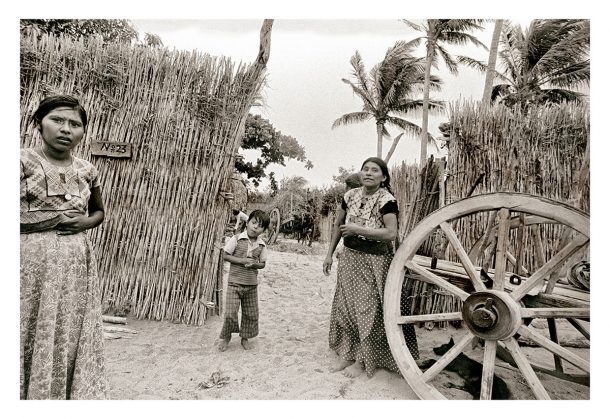 Día uno, San Mateo del Mar, Oaxaca, 1976 © Pablo Ortíz Monasterio
Día uno, San Mateo del Mar, Oaxaca, 1976 © Pablo Ortíz Monasterio And what did you discover looking back?
I started the project in 1976 after returning from studying photography in England for three years. I quickly realised that my compositions were stiff and full of ideology – editing out the electricity cables or the Coca Cola signs, for example. I was imposing my ideas of purity and strength on an indigenous people. There’s one photograph from the first trip I have no memory of taking: the horizon is tilted and the cropping is harsh – you see part of a woman, and part of a wheel. I had been walking around San Mateo del Mar and I saw a group of people replacing the palm roof of a house. The scene was wonderful, but as soon as the woman next to the wheel saw me, she walked towards me with the attitude that I should not be taking pictures. Out of nervousness I released the shutter without looking through the camera. The composition seemed more relaxed. From then on I photographed with a wide-angle lens, not looking through the viewfinder, trying not to impose my point of view.
So coming back to your question, looking through the negatives was a reconstruction of memory. It was interesting to observe the young photographer I was then. Some images surprised me, so I scanned all the pictures from the original book plus 45 ‘new’ ones. In the process I realised that after 40 years I am not a better photographer, although probably I am wiser.
I am struck by how many Mexican photographers of your generation and younger have photographed Mexico’s indigenous peoples – communities consistently marginalised since the Spanish conquests. It’s a very complex visual heritage. Was this the legacy of the 1960s in Mexico?
No, it goes back further: the indigenous peoples of Mesoamerica have been the subject of photography since its arrival in Mexico in the nineteenth century. Mexican Indians kept alive cultural traditions through resistance, especially in remoter communities. It’s always tempting to document realities that are on the verge of disappearing, to memorialise those things that make us Mexican. Among other subjects, I was interested in documenting horizontal forms of indigenous social organisation, where the final word belongs to the assembly. So you are right to connect this to the 1960s and to the struggle for a more democratic Mexico. For photographers of my generation the legacy of the student movement was very present. We regarded the Indian nations as a great example for contemporary Mexican society.
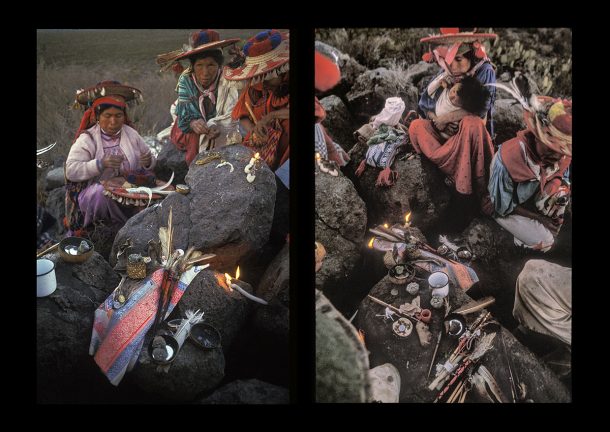 Offerings in Virikuta, Sacred Territory where the Sun was Born and the Peyote Grows, San Luis Potosí Mexico, about 1994 © Pablo Ortíz Monasterio
Offerings in Virikuta, Sacred Territory where the Sun was Born and the Peyote Grows, San Luis Potosí Mexico, about 1994 © Pablo Ortíz Monasterio And at much the same time Mexican photographers were beginning to organise, a process in which you were intimately engaged. In 1976 the Consejo Mexicano de Fotografía (Mexican Council of Photography) was founded, followed by a whole series of colloquia, workshops and exhibitions concentrating on Latin American photography. In retrospect it seems an intensely innovative period, driven largely by photographers.
In Europe, North America, and Japan photography began to be recognised as an art form in museums during the early 1970s. In Mexico it took a little longer. But we were lucky to have Pedro Meyer among us, a photographer and organiser, who had seen my pictures in the British magazine, Creative Camera, in 1976. He brought us all together and we met weekly to discuss photography. We didn’t think of ourselves as artists, but rather called ourselves documentary photographers, committed to humanistic values and to exploring the life and struggles of our people.
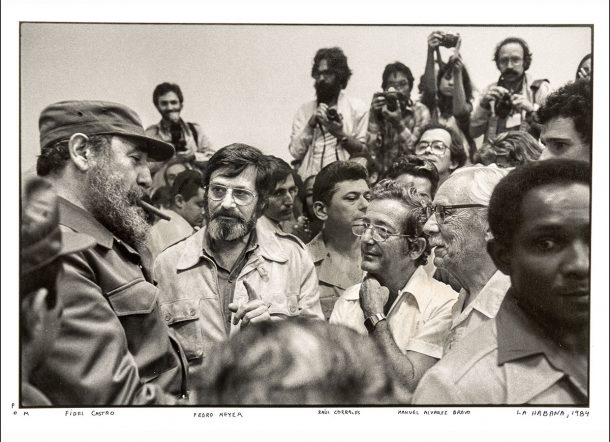 Fidel Castro, Pedro Meyer, Raúl Corrales and Manuel Álvarez Bravo, Havana, 1984 © Pablo Ortíz Monasterio
Fidel Castro, Pedro Meyer, Raúl Corrales and Manuel Álvarez Bravo, Havana, 1984 © Pablo Ortíz Monasterio In those weekly meetings we would spend time looking at pictures and generating critique of what was good and, more importantly, why. It was a challenging and enriching period. Then in 1980 the Council established the first photography biennial in Mexico City. Matters were discussed openly and afterwards members voted. It was quite democratic, although at the same time some voices carried more weight than others.
Your major work of the 1990s is La última ciudad (The Last City, 1995), a photo book about Mexico City. It features the people of the city and has a compressed vitality that I really love. How did you go about photographing a megalopolis as vast as Mexico City?
I started the project in the late 1980s and it took me almost a decade to complete it. From the beginning it was clear to me that the final piece was going to be a book and I was taking pictures with that in mind. You see this in the composition of the photographs: not having the main element of your picture in the centre, such as the boy jumping, works well in the double page; the gutter doesn’t obstruct your main subject and allows you to bring other elements, and a different meaning, into the picture. The energy of the jump is more than enough to make this a good picture, but the gun adds violence, danger, noise, making it closer to the complexity of the city.
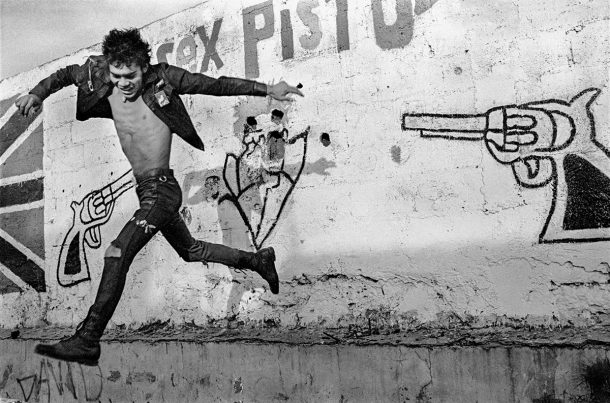 Low Flying, Mexico City, 1988 © Pablo Ortíz Monasterio
Low Flying, Mexico City, 1988 © Pablo Ortíz Monasterio It took me a long time to work out what to say about Mexico City, the place I had lived in most of my life. I would trace routes on a map, to have my body with a camera progress through the city – all of it – if that was ever possible. Soon I abandoned the idea of describing the city or making a portrait of it. Instead, I became interested in revealing the energy of the people, and what a walker in the city might experience.
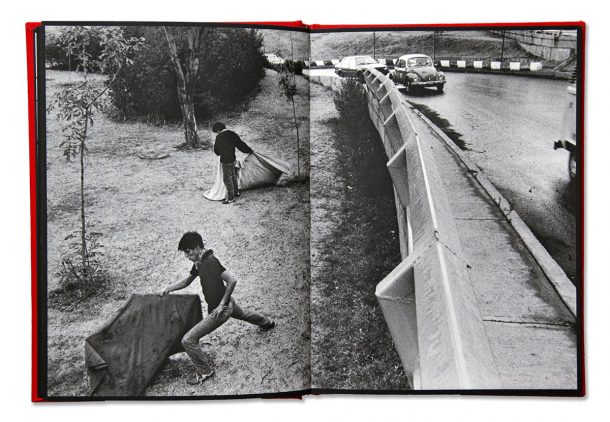 Spread from The Last City (1995)
Spread from The Last City (1995) Much of your recent work reveals an intriguing shift towards historical subjects or past events that have a life in the present. These include your recent zine, Ocupacíon militar (2018), about the legacy of the events of 1968 and the student movement in Mexico City. It represents an increasingly playful approach to documentary narrative, incorporating fictive elements. Does historical memory always need to be reconstructed for the present?
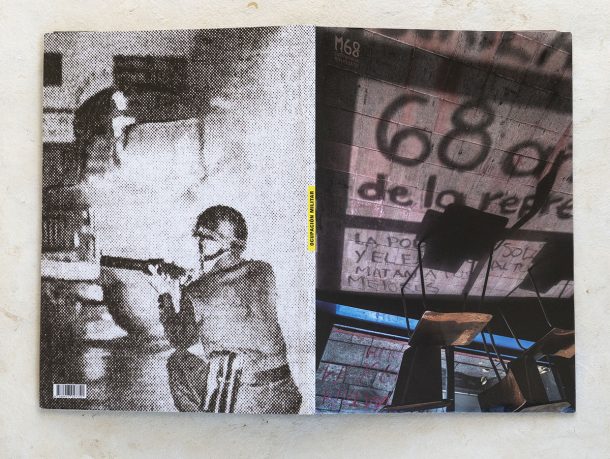 Front and back cover, Ocupacíon militar (2018)
Front and back cover, Ocupacíon militar (2018) 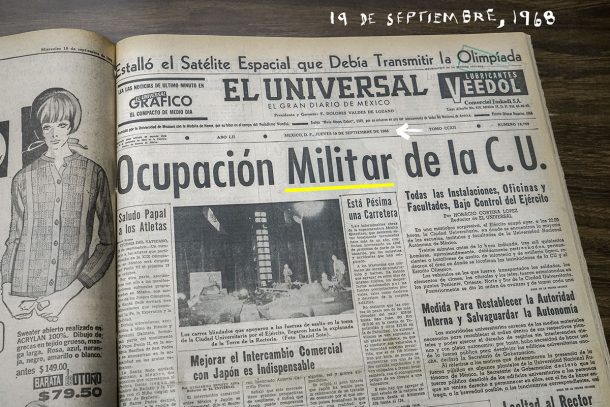 Ocupacíon militar (2018) © Pablo Ortíz Monasterio
Ocupacíon militar (2018) © Pablo Ortíz Monasterio 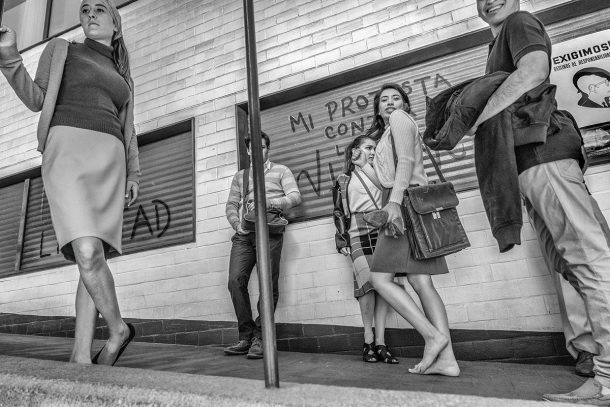 Ocupacíon militar (2018) © Pablo Ortíz Monasterio
Ocupacíon militar (2018) © Pablo Ortíz Monasterio The reconstruction of political events you mention, well that’s important. Ocupacíon militar is a deliberately harsh production. It is badly printed, on poor quality paper. However, I find it works well – the images are not as precise as you would see on a screen, and this brings the archival material into a closer relationship with the contemporary photography. The book is about a specific day, the 19 September 1968, when the army occupied the UNAM, the National Autonomous University of Mexico in the south of Mexico City. Its narrative is linked to a recent feature film, Olimpia (2019), about the same subject, in which my daughter has a role. I also reproduce parts of the script in the book. So the whole project is constantly moving between reconstruction, generational experience, and the documents from the period.
Pablo, thank you very much. We look forward to exploring your archive further on Instagram.
Further reading
Pablo Ortíz Monasterio Instagram
Selected photo books by Pablo Ortíz Monasterio:
Los Pueblos del Viento: crónica de mareños, Martín Casillas Editores, 1981
Testigos y Complices, Martín Casillas Editores, 1982
Tierra de Árboles y Bosques, Inversora Bursátil, 1988
The Last City, Twin Palms Publishers, 1995
Dolor y Belleza, Landucci Editores, 2000
Montaña Blanca, Fondo de Cultura Económica/Editorial RM, 2010
Akadem Gorodok, Consejo Nacional para la Cultura y las Artes/Editorial RM, 2014
2 Tiempos, LOM Ediciones/Editorial RM, 2014
Desaparecen?, Nazraeli Press, 2016
Ocupacíon militar, RM Verlag, 2018
Contact ALMANAQUE fotográfica
| Address : | Colima 101 PB, Roma Nte., Cuauhtémoc, 06700 Ciudad de México, CDMX, Mexico |
| Website : | http://www.almanaquefotografica.com/ |
| Categories : | |
| City : | CDMX |

|
I
|
Ivette Morale´s on Google
★ ★ ★ ★ ★ Acudí hace unos días para ver la exposición actual y al llegar estaba cerrado, había una persona dentro trabajando en un escritorio, tocamos el timbre e incluso nos paramos un rato afuera para que nos viera está persona y no siquiera miro al exterior.
El horario que acudí fue entre las 1 y 2 de la tarde, tenía colocado el letrero de abierto.
Qué mal que camine mucho para llegar al lugar y al final vi la exposición desde la calle.
I went a few days ago to see the current exhibition and when it was closed, there was a person working at a desk, we rang the bell and even stood outside for a while to see this person and I did not even look outside.
The time I went was between 1 and 2 in the afternoon, I had placed the open sign.
Too bad I walk a lot to get to the place and at the end I saw the exhibition from the street.
|
|
H
|
Hernandez Contreras Guadalupe on Google
★ ★ ★ ★ ★ Fuimos al pop up de shein, el personal y la experiencia muy amena
We went to shein's pop up, the staff and the experience very enjoyable
|
|
E
|
Eduardo Dorantes on Google
★ ★ ★ ★ ★ Una pequeña galería, con una extraordinaria muestra de fotógrafos de distintos países
A small gallery, with an extraordinary sample of photographers from different countries
|
|
K
|
Karina Alarcon on Google
★ ★ ★ ★ ★ One of my fav places. Great curation. White and relax environment.
|
|
R
|
Ruairidh Farquharson on Google
★ ★ ★ ★ ★ Cool exhibition, did not feel welcome by rude staff member.
|
|
C
|
CubeInTheBox on Google
★ ★ ★ ★ ★ An awesome photography and graphics gallery in one of the most beautiful places in Mexico City
|
|
D
|
D Roche on Google
★ ★ ★ ★ ★ Fantastic Gallery, They 100% know their field. Highly Recommend.
|
|
F
|
Francisco Rojas on Google
★ ★ ★ ★ ★ The best contemporary photo art gallery in Mexico!!
|
Write some of your reviews for the company ALMANAQUE fotográfica
Your reviews will be very helpful to other customers in finding and evaluating information
Recommend a place for you










